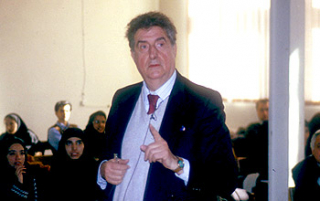It is with sadness that ICCROM announces the recent passing of Maurizio Marabelli on 19 September 2017, after a long illness.
A graduate of Chemistry from the Sapienza University of Rome, he began his career in 1964 at the Istituto Centrale del Restauro (ICR; now Istituto Superiore per la Conservazione ed il Restauro ̶ ISCR). In 1980 he became the Director of the Chemistry Laboratory, a position he kept until his retirement in 2001.
His main fields of study and scientific interest were: the conservation of metals and wall paintings, the application of non-destructive analytical techniques, and the monitoring of air pollutants and their effects on both indoor and outdoor works of art.
Out of the many important monuments he studied, the four gilded bronze horses of St. Mark’s Basilica in Venice and the gilded bronze equestrian sculpture of Marcus Aurelius on Rome’s Capitoline Hill are perhaps the most notable and internationally renowned. As for mural paintings, his work on Da Vinci’s Last Supper in Milan, and Giotto’s pictorial cycle of the Scrovegni Chapel in Padua, come to mind.
Maurizio planned and implemented several campaigns to monitor air pollution at many important sites and monuments, both in Italy (for example, Trajan’s Column in Rome) and in other countries. In 1991 during the Gulf War, he was involved in a research project which studied the effects of pollution caused by burning oil wells in Kuwait on cultural property in Iran. This was done at the request of the Regional Centre for the Conservation of Cultural Relics in Tehran.
His experience as a teacher and lecturer was vast and spanned his professional life. In addition to providing training at the ICR’s school of restorers, he also lectured on courses held at the Institute of Restoration in Xi’an and at the Training Center of Conservation and Restoration for Cultural Property in Bejing, China, as well as the Restoration Institute of Lucknow, Uttar Pradesh, India. In Italy, he lectured at Tuscia University in Viterbo and the Sapienza University of Rome.
Throughout his career he collaborated closely with ICCROM, lecturing regularly on courses and participating in several technical missions. Courses that benefitted from his expertise included the Architectural Conservation course (ARC), the Mural Paintings course (MPC), Scientific Principles of Conservation (SPC), and ANMET (Non Destructive and Micro Destructive Analytical Methods for the Conservation of Works of Art and Historic Buildings).
ICCROM missions and projects included: analyses of Al Aqsa and the Dome of the Rock in Jerusalem (1979), conservation of the Taj Mahal (1987), and the ICCROM-CURRIC project to provide vocational training curricula to conservation scientists (2000-2003), among several others.
Maurizio was one of Italy’s pioneers for the application of non-destructive techniques to the study of cultural property. In this capacity, he helped organize the “Non-Destructive Testing, Micro-analytical Methods for the Diagnostics and Conservation of Cultural and Environmental Heritage” international conferences, and edited the proceedings of the first eight editions.
He published more than 150 papers and four books, contributing enormously to the field of chemistry as applied to cultural property.
ICCROM extends its deepest condolences to Maurizio Marabelli’s family, friends, and professional colleagues worldwide.
Marisa Laurenzi Tabasso


